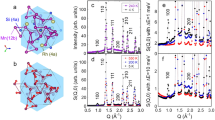Abstract
We have studied in detail the A-phase region in the field-temperature (H-T) phase diagram of the cubic heli-magnet MnSi using small angle neutron diffraction. The A-phase revealed itself as a two-dimensional hexagonal pattern of Bragg spots with k h(1, 2, 3) ⊥ H. The directions and magnitudes of the wave vectors k h(1, 2, 3) are well preserved over the whole crystal of the size of 100 mm3, but in the small room of the (H-T) phase diagram just below T c = 29 K. The droplets of the orientationally disordered, presumably hexagonal, spin structure with k h ⊥ H are observed in the wide range beyond the A-phase boundaries in the field range from B T1 ≈ 0.1 T to B T2 ≈ 0.25 T at temperatures down to 15 K. No melting of these droplets into individual randomly located skyrmions is observed for all temperatures and magnetic fields. The wave vector of two-dimensional modulations k h is equal to the wave vector of the cone phase k c . We conclude that observable is a two dimensionally modulated hexagonal spin superlattice built on the same competition of interactions (ferromagnetic exchange and Dzyaloshinskii-Moriya interactions) similar to a case of one-dimensionally modulated simple spin spiral.
Similar content being viewed by others
References
Y. Ishikawa, K. Tajima, D. Bloch, and M. Roth, Solid State Commun. 19, 525 (1976).
P. Bak and M. H. Jensen, J. Phys. C 13, L881 (1980).
I. E. Dzyaloshinskii, Sov. Phys. JETP 19, 960 (1964).
Historically, the Dzyaloshinskii-Moria interaction was first introduced to explain the phenomenon of weak ferromagnetism in centrosymmetric crystals. Generally the presence/absence of DM interaction is associated with the local symmetry of the interatomic bonds and it leads to a spiral twist of the magnetic structure in magnets without inversion center.
M. Tanaka, H. Takayoshi, M. Ishida, and Ya. Endoh, J. Phys. Soc. J. 54, 2970 (1985).
M. Ishida, Ya. Endoh, S. Mitsuda, Yo. Ishikawa, and M. Tanaka, J. Phys. Soc. J. 54, 2975 (1985).
S. Kusaka, K. Yamamoto, T. Komatsubara, and Y. Ishikawa, Solid State Commun. 20, 925 (1976).
K. Ishimoto, H. Yamaguchi, Y. Yamaguchi, J. Suzuki, M. Arai, M. Furusaka, and Y. Endoh, J. Magn. Magn. Mater. 90–91, 163 (1990).
K. Ishimoto, Y. Yamaguchi, J. Suzuki, M. Arai, M. Furusaka, and Y. Endoh, Physica B 213–214, 381 (1995).
B. Lebech, P. Harris, J. Skov Pedersen, K. Mortensen, C. I. Gregory, N. R. Bernhoeft, M. Jermy, and S. A. Brown, J. Magn. Magn. Mater. 140, 119 (1995).
S. V. Grigoriev, S. V. Maleyev, A. I. Okorokov, Yu. O. Chetverikov, and H. Eckerlebe, Phys. Rev. B 73, 224440 (2006).
S. V. Grigoriev, S. V. Maleyev, V. A. Dyadkin, D. Menzel, J. Schoenes, and H. Eckerlebe, Phys. Rev. B 76, 092407 (2007).
S. V. Grigoriev, V. A. Dyadkin, Yu. O. Chetverikov, D. Menzel, J. Schoenes, A. I. Okorokov, H. Eckerlebe, and S. V. Maleyev, Phys. Rev. B 76, 224424 (2007).
S. Mühlbauer, B. Binz, F. Jonietz, C. Pfleiderer, A. Rosch, A. Neubauer, R. Georgii, and P. Böni, Science 323, 915 (2009).
C. Pfleiderer, T. Adams, A. Bauer, W. Biberacher, B. Binz, F. Birkelbach, P. Böni, C. Franz, R. Georgii, M. Janoschek, F. Jonietz, T. Keller, R. Ritz, S. Mühlbauer, W. Münzer, A. Neubauer, B. Pedersen, and A. Rosch, J. Phys.: Condens. Matter 22, 164207 (2010).
A. Neubauer, C. Pfleiderer, B. Binz, A. Rosch, R. Ritz, P. G. Niklowitz, and P. Böni, Phys. Rev. Lett. 102, 186602 (2009).
W. Münzer, A. Neubauer, T. Adams, S. Mühlbauer, C. Franz, F. Jonietz, R. Georgii, P. Böni, B. Pedersen, M. Schmidt, A. Rosch, and C. Pfleiderer, Phys. Rev. B 81, 041203 (2010).
H. Wilhelm, M. Baenitz, M. Schmidt, U. K. Rößler, A. A. Leonov, and A. N. Bogdanov, Phys. Rev. Lett. 107, 127203 (2011).
E. Moskvin, S. Grigoriev, V. Dyadkin, H. Eckerlebe, M. Baenitz, M. Schmidt, and H. Wilhelm, Phys. Rev. Lett. 110, 077207 (2013).
T. Adams, S. Muhlbauer, C. Pfleiderer, F. Jonietz, A. Bauer, A. Neubauer, R. Georgii, P. Böni, U. Keiderling, K. Everschor, M. Garst, and A. Rosch, Phys. Rev. Lett. 107, 217206 (2011).
X. Z. Yu, Y. Onose, N. Kanazawa, J. H. Park, J. H. Han, Y. Matsui, N. Nagaosa, and Y. Tokura, Nature 465, 901 (2010).
X. Z. Yu, N. Kanazawa, Y. Onose, K. Kimoto, W. Z. Zhang, S. Ishiwata, Y. Matsui, and Y. Tokura, Nature Mater. 10, 106 (2011).
A. Tonomura, X. Yu, K. Yanagisawa, T. Matsuda, Y. Onose, N. Kanazawa, H. S. Park, and Y. Tokura, Nano Lett. 12, 1673 (2012).
U. K. Rößler, A. N. Bogdanov, and C. Pfleiderer, Nature 442, 797 (2006).
U. R. Rößler, A. A. Leonov, and A. N. Bogdanov, J. Phys.: Conf. Ser. 303, 012105 (2011).
A. Neubauer, C. Pfleiderer, B. Binz, A. Rosch, R. Ritz, P. G. Niklowitz, and P. Boni, Phys. Rev. Lett. 102, 186602 (2009).
The internal magnetic field was calculated using the expression \(B_{\operatorname{int} } = B_{ext} - 4\pi {\rm M}\hat {\rm N}\), where N was taken equal to 1 if H is perpendicular to the sample plate. The magnetization was considered to be proportional to an external field M = χH with χ = const depending on the temperature and extracted from the magnetization measurements. Thus, corrected magnetic field may have a systematic error of about 5%.
N. Potapova, V. Dyadkin, E. Moskvin, H. Eckerlebe, D. Menzel, and S. Grigoriev, Phys. Rev. B 86, 060406(R) (2012).
V. E. Dmitrienko and V. A. Chizhikov, Phys. Rev. Lett. 108, 187203 (2012).
V. A. Chizhikov and V. E. Dmitrienko, Phys. Rev. B 88, 214402 (2013).
O. Petrova and O. Tchernyshyov, Phys. Rev. B 84, 214433 (2011).
Author information
Authors and Affiliations
Corresponding author
Additional information
The article is published in the original.
Rights and permissions
About this article
Cite this article
Grigoriev, S.V., Potapova, N.M., Moskvin, E.V. et al. Hexagonal spin structure of A-phase in MnSi: Densely packed skyrmion quasiparticles or two-dimensionally modulated spin superlattice?. Jetp Lett. 100, 216–221 (2014). https://doi.org/10.1134/S0021364014150065
Received:
Accepted:
Published:
Issue Date:
DOI: https://doi.org/10.1134/S0021364014150065




